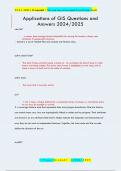2 0 2 4 /2025 | © copyright | This work may not be copied for profit gain Excel!
Applications of GIS Questions and
Answers 2024/2025
.shp file*
- a vector data storage format (shapefile) for storing the location, shape, and
attributes of geographic features.
- stored in a set of related files and contains one feature class.
active data frame*
The data frame currently being worked on - for example, the data frame to which
layers are being added. The active data frame is highlighted on the map, and its
name is shown in bold text in the table of contents.
active layer
The layer that is currently active.
arc*
1. On a map, a shape defined by a connected series of unique x,y coordinate pairs.
An arc may be straight or curved.
2. a coverage feature class that represents lines and polygon boundaries. One line feature
can contain many arcs. Arcs are topologically linked to nodes and to polygons. Their attributes
are stored in an arc attribute table (AAT). Nodes indicate the endpoints and intersections of
arcs; they do not exist as independent features. Together, the from-node and the to-node
define the direction of the arc
ArcGIS*
1|Page| GradeA+ | 2 0 0 2 5
,2 0 2 4 /2025 | © copyright | This work may not be copied for profit gain Excel!
A suite consisting of a group of geographic information system (GIS) software
products produced by ESRI. It is a system for working with maps and geographic
information. It is used for: creating and using maps; compiling geogrpahic data;
analyzing mapped information; sharing and discovering geographic information;
;using maps and geogrpahic information in a range of applications; and managing
geographic information in a database.
ArcGIS documents
it is the map blah blah
area feature
One of the three types of features: point, line, and area. The area feature is a 2D
plane produced by a polygon of a certain shape.
arithmetic function
A type of methematical function that performs a calculation on the values of cells in an
input raster. There are six arithmetic functions in ArcGIS Spatial Analyst: Abs, Int, Float,
Round up (Ceil), Round down (Floor) and Negate
Operators
Arithmetic - *, /, -, +
Boolean - True or False
Relational - ==, >, <, <>, >=, <=
ASCII files*
"American Standard Code for Information Interchange". The de facto standard for the
format of text files in computers and on the internet that assigns an 8-bit binary
number to each alphanumeric or special character. ASCII defines 256 possible
characters.
attributes*
1|Page| GradeA+ | 2 0 0 2 5
,2 0 2 4 /2025 | © copyright | This work may not be copied for profit gain Excel!
Nonspatial information about a geogrpahic feature in a GIS, usually stored in a table
and linked to the feature by a unique identifier. For example, attributes of a river
might include its name, length, and sediment load at a gauging station.
attribute query*
A request for records of features in a table based on their attribute values
attribute table
A database or tabular file containing information about a set of geographic features,
usually arranged so that each row represents a feature and each column represents
one feature attribute. In raster datasets, each row of an attribute table corresponds to
a certain zone of cells having the same value. In a GIS, attribute tables are often
joined or related to spatial data layers, and the attribute values they contain can be
used to find, query, and symbolize features or raster cells.
attribute table: field and records
Field are the columns. Records are the rows.
auto-label*
A tool that automatically labels a certain layer based on a selected field (usually
NAME)
bitmap*
An image format in which one or more bits represent each pixel on the screen. The
number of bits per pixel determines the shades of gray or number of colors that a
bitmap can represent
Boolean expression*
1|Page| GradeA+ | 2 0 0 2 5
, 2 0 2 4 /2025 | © copyright | This work may not be copied for profit gain Excel!
an expression, named for the English mathematician George Boole (1815-1864), that
results in a true or false (logical) condition. For example, in the Boolean expression
"HEIGHT > 70 AND DIAMETER = 100," all locations where the height is greater than
70 and the diameter is equal to 100 would be given a value of 1, or true, and all
locations where this criteria is not met would be given a value of 0, or false.
Boolean operator
a logical operator used in the formulation of a Boolean expression. Common Boolean
operators include AND, which specifies a combination of conditions (A and B must be
true); OR, which specifies a list of alternative conditions (A or B must be true); NOT,
which negates a condition (A but not B must be true); and XOR (exclusive or), which
makes conditions mutually exclusive (A or B may be true but not both A and B).
byte
The smallest addressable unit of data storage within a computer; almost always
equivalent to 8 bits and containing one character.
CAD
(Computer-Aided Design). A computer-based system for the design, drafting, and
display of graphical information. Such systems are mostly commonly used to support
engineering, planning, and illustrating activities.
CAD feature class
A read-only member of a CAD feature dataset, comprised of one of the following:
polylines, points, polygons, multipatch, or annotation. The feature attribute table of a
CAD feature class is a virtual table comprised of select CAD graphic properties and
any existing field attributes values.
cell*
The smallest unit of information in raster data, usually square in shape. In a map or
GIS dataset, each cell represents a portion of the earth, such as a square meter or
square mile, and usually has an attribute value associated with it, such as soil type or
vegetation class.
1|Page| GradeA+ | 2 0 0 2 5




